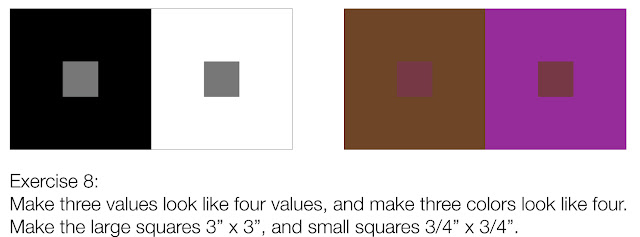Class, Because of time constraints, we are skipping exercise 5. For Wed, please do Exercises 6 and 7. Each exercise should be mounted to mat board with 2" border.
DUE WED, APRIL 12th.
Exercise 6
consists of 4 different compositions. Each composition should measure 4" x 2.5" overall. NOTE: FOR EXERCISE 6 ONLY, YOU MAY USE ILLUSTRATOR, OR ANY OTHER MEDIA, INSTEAD OF PAINT SWATCHES. Regardless of the medium you choose, you CAN NOT blend colors. They must all be solid and limited to 4 colors used across all 4 compositions
Ex. You could use the following paint swatches in 4 different compositions that communicate very differently: canary yellow, periwinkle blue, sun red, lemon. Each composition would use only these 4 colors, but in different quantities, in different placement, and interacting differently.
Exercise 7
THIS MUST BE DONE USING PAINT SWATCHES. Your composition must measure 3" high x 12" wide. Cutting clean and straight will be important. The goal is to use color repetition and proximity to create the illusion of more colors that you are using. YOU WILL ONLY USE THREE DIFFERENT COLORS of paint swatches. How many more colors can you create through Visual Mixture? Challenge yourself to make at least 6 colors appear.
Exercise 8
Exercise is done with 3" squares and 1" squares. Should be mounted with 2" border.
Do your best with this one. You will need to pick three colors that give the illusion of 4 colors. The small 1" square is the color that will appear to shift into a 4th color depending on the ground (large square surrounding it).
Do this exercise once with a shift in value (grayscale) and another time with a shift in hue.









